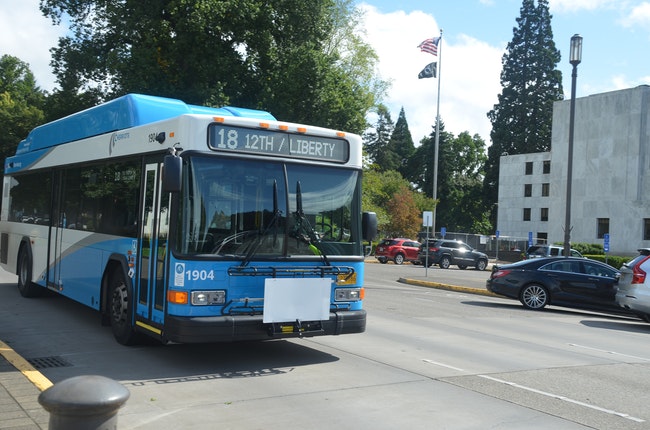
A Cherriots bus on State Street outside the Oregon Capitol (Rachel Alexander/Salem Reporter)
If there was a bus line connecting Salem and Albany, would people ride it?
That’s a central question of a study Cherriots is conducting. The transit agency is considering a new line connecting the cities as well as smaller communities nearby.
If there is enough support, a pilot program trying out the new service could be on the road a year or two after the study is completed this summer, said Stephen Dickey, Cherriots director of technology and program management.
Dickey said the transit agency began considering connecting the two cities after concluding a study a few years ago of its regional transit service, which extends to communities in the Santiam Canyon and Polk County.
He said the study highlighted factors in the area that point to the feasibility of extending a line to Albany.
The study showed that before the pandemic, a considerable number of people had been commuting between the two cities, he said. A bus line would serve those commuters while connecting Cherriots with regional transit networks that serve Corvallis, Sweet Home, as well as parts of Benton and Linn counties.
The last time Cherriots extended its service was to Wilsonville in the 1990s, said Dickey. Linking to other local transit services can greatly enhance mobility for someone who may not be able to drive or doesn’t have a car by choice, he said. More bus service could free up highway capacity, and some commuters would rather open a book or their laptop on their trip home than get behind the wheel, he said.
“When you begin to look at these networks that have been developed, sometimes there are just small gaps that can greatly enhance people’s opportunity to be able to travel,” he said.
Jefferson and Millersburg, two small towns north of Albany, have seen growth in population in recent years, but not jobs, so residents have to commute for employment, he said. The new bus line could serve these communities as well, he said.
The Oregon Legislature passed a landmark $5.3 billion transportation bill in 2017. Dickey said the bill provided funding to study the feasibility of regional transportation projects. In late 2020 Cherriots launched a feasibility study into the new bus line, he said Dickey.
Dickey said the first question the study will seek to answer is, Will people use a Monday through Friday bus service between Albany and Salem? He said the next questions will be about route timing, frequency and cost.
Further questions, he said, would include whether to run a commuter express between the two cities or include smaller communities along the way. As Cherriots considers whether to move forward on the bus line, Dickey said central questions will be whether there is enough demand and what kind of fares potential commuters would be willing to pay.
Dickey said Albany residents are more likely to use the bus to travel to Salem, with its high number of government jobs, than the other way around.
Currently, the only transit options between Salem and Albany are Amtrak and the Cascades POINT bus, a service offered by the Oregon Department of Transportation. However, tickets on those services are four to six times as expensive as Cherriots’ regional fare, which ranges from $2.25 or $3 depending on the route. Both those services bypass Jefferson and Millersburg.
According to numbers provided by the Oregon Department of Transportation, 1,544 people used the Cascades POINT bus in 2019, which fell to 401 in 2020 because of the pandemic. For Amtrak, a total of 2,767 used the service to travel between the two cities in 2019, according to department numbers (it didn’t have complete numbers for 2020).
“We are hearing about a slight increase, anecdotally, as companies call workers back into the office and businesses re-open – and we hope as more of us get our shots, that increase will continue,” said Shelley Snow, Department of Transportation spokeswoman, in an email.
Another important consideration will be whether the route is supported by the Albany Area Metropolitan Planning Organization and the Salem-Keizer Area Transportation Study committee, said Dickey. Both are comprised of local elected representatives and are responsible for planning transportation projects.
“Both of those also really need to be on board because of how funding flows to support projects,” he said.
Catherine Rohan, assistant transportation planner with the Albany Area Metropolitan Planning Organization, said in an email that her organization is working with Cherriots on studying the feasibility of the new bus line.
She pointed to the 2018 Albany Area Regional Transportation Plan that references commuting patterns to Salem. According to the plan, 2,188 people commute from Albany to Salem or Keizer for work. Less than 1% of Albany commuters use transit, according to the plan.
“We haven’t looked at the Salem to Albany connection in much depth before, which is what makes this study really exciting!” she said.
Dickey said the feasibility study will be wrapped up in June or July. Because the pandemic upended traffic patterns, he said the study used on data from earlier years.
Because of the pandemic, Cherriots has had to rely on the internet to get public input, which Dickey called a “silver lining” that’s given more people the chance to comment.
“What we have found is we get a higher number of participants than we do in the old traditional open-house approach,” he said. “And we also get a much broader coverage of the demographic makeup of our communities.
While the initial survey closes at midnight Friday, April 2, he said there will be further chances for the public to weigh in as the plan is considered by various public bodies including the Cherriots board.
Contact reporter Jake Thomas at 503-575-1251 or [email protected] or @jakethomas2009.
SUBSCRIBE: A monthly digital subscription starts at $5 a month.
GIFT: Give someone you know a subscription.
ONE-TIME PAYMENT: Contribute, knowing your support goes towards more local journalism you can trust.









